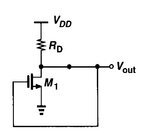amsdesign
Member level 3

Hello everyone,
So far my understanding for oscillators is this :
1) Total loop phase shift should be 360 degrees
2) The loop gain should be more than 1 so that the signal is amplified in its path and not attenuated.
3) The feedback loop automatically presents a 180 phase shift of the signal

Assuming that inverter is a simple common source NMOS. The MOS provides a 180 phase shift and the loop feedback provides another 180 degrees. So 360 in all.
Why doesn't this serve as an inverter?
So far my understanding for oscillators is this :
1) Total loop phase shift should be 360 degrees
2) The loop gain should be more than 1 so that the signal is amplified in its path and not attenuated.
3) The feedback loop automatically presents a 180 phase shift of the signal

Assuming that inverter is a simple common source NMOS. The MOS provides a 180 phase shift and the loop feedback provides another 180 degrees. So 360 in all.
Why doesn't this serve as an inverter?



